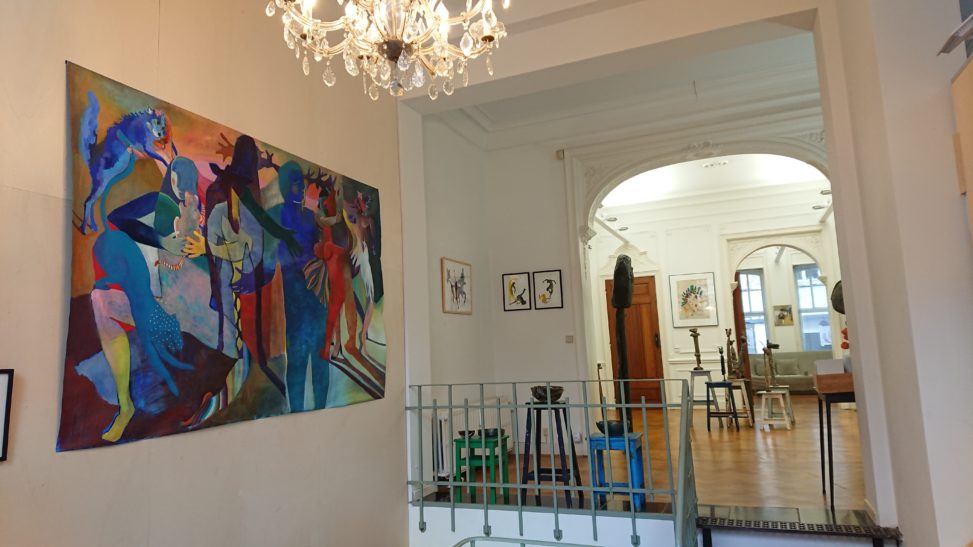Retrouvez l’article en ligne avec les images :
Le texte :
Embracing our Animal Shadows
Patrick ten Brink 6 April 2023
Travel tomorrow
Travel Tomorrow is a global media reporting on the travel and tourism industry.
Travel Tomorrow is a flagship brand of Buscardini Communications, a Brussels-based communications agency.
Many colourful gems can be discovered in small galleries run by passionate individuals wishing to give art its space, and Sybille Mathiaud and co-artist’s Bénédicte van Caloen exhibition – La Part Animale – at the Espace-Privé in Brussels is just that – a colourful discovery. To me, it is also a playful, yet serious exploration of humankind’s relationship with nature, and more specifically even, our relationship to the animal in us, not in the sense of violent or hungry or dumb or sexual, but rather contemplative and graceful, joyful and energetic, and even deeply complementary and symbiotic.
I’ll start with Sybille’s elegant animal shadows and leave the piece de resistance to last. We all know the Greek mythological tale of Narcissus who stared at the beauty of his reflection in the water and fell in love with himself, wasted away and died— a warning of the dangers of excessive self-involvement, made already in the 8th century before our era (see Book III of Ovid’s Metamorphoses). In Sybille’s work, we don’t have self-destructive self-contemplations, but rather a healthy contemplation – a woman considering her rooster shadow, a pregnant woman considering motherhood for the marsupial kangaroo and another woman arm in wing with an ostrich, beholding a horizon, perhaps the future, together.
This quiet contemplation is welcome in these troubling times; we need to know ourselves to chart our way through the accelerated present. It is also ironic, the mutual help and connection as much of humanity is driving so many wild animals to extinction. The painting of the couple and the crocodile shows the calm slumber of two humans on a crocodile who, to me, complains as he, or she, carries humanity and groans under the weight of us, blissfully unaware. Who is the predator? We are in the Anthropocene era, not the Jurassic. I don’t know if this was the artists’ intention, but the slightly depressed and resigned look on the monkey, say it all – can’t you see what you are doing to our home, your home, and how you exploit it?
Sybille Mathiaud also explores how animals and humans rub off on each other, awkwardly at first – with the leopard spots on human skin – and fluidly after, with the zebra stripes. I wonder whether tattoo artists will be asked to capture one’s animal on skin.
And finally, to the most beautiful of her work – the dance. Animals and humans dance together, fear and exploitation forgotten and forgiven. The wolf at the top left inevitably reminds us of little red riding hood, the antlers in the top middle are like an all-embracing crown, bottom left there is the panther who loses his spots that become like stars looking for a new home, perhaps these will travel to the blue man in middle whose skin is like the sky and whose arms are open to embrace the new reality. It is a positive painting, one of hope.
Looking closer — the painting also shows the struggle for this metamorphosis of humanity – the dancing man at the top right looks like a struggling, groaning, golem, reluctant to join the dance, yet the owl speaks wisdom, and the white dove purity and soul, encouraging him. There is hope for the human golem to dance, to become like the blue-sky man in the middle. If only he hears and heeds the words of animals.
Sybille’s paintings are a welcome reminder that we should stop and think about our relationship to nature, to the animal in us as we rush into the world of artificial intelligence. And listen to animal intelligence. It is all around us if only we take the time to look, listen, discover. Science has proven what many already knew – that animals have emotions and intelligence, even culture. Every year, proof adds to proof of animal sentience, of consciousness and identity.
Sybille Mathiaud’s contemplative pieces were inspired by the article “Comment “sauver” l’etre humain par l’Animal?” (How to save the human being through animals) by Georges Chapouthier. Exploring, recognising and accepting our animal shadows is an antidote to the robotisation of humanity and the dislocation as AI advances. Her work was also inspired by a trip to Columbia, where people’s relationship with nature is far from the European reality.
The exhibition is a brief one – until the 9th of April 2023 – and also shows moving sculptures of animals by Bénédicte van Caloen, with their different expressions. If you are too late for this exhibition, keep any eye out for Sybille and Bénédicte’s next exhibitions and those of the Espace-Privé. In the meantime it could be fun to contemplate what part of us that is animal, that is still connected to nature and wonder what we can discover here and around us.
